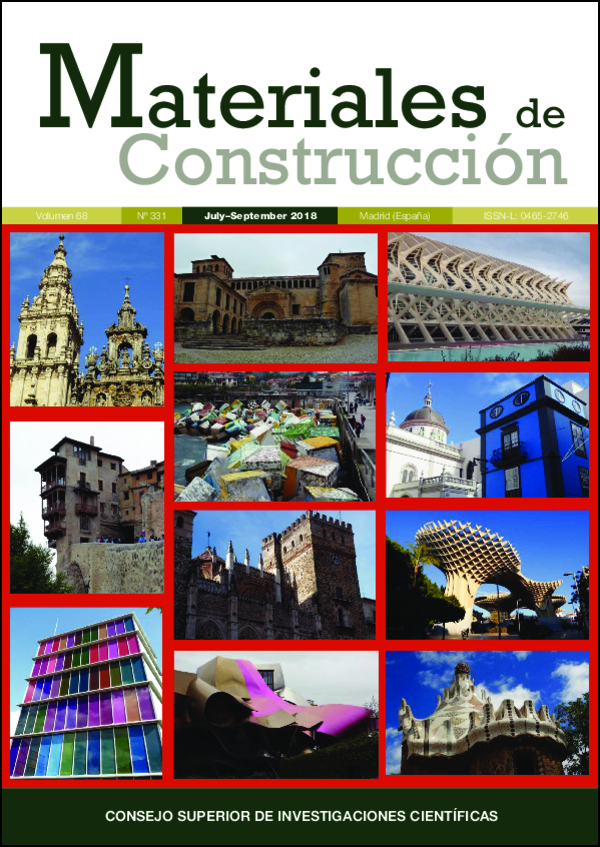Synthetic waterproofing membranes and auxiliary separating layers in the inverted flat roof. Pressure effect on the degradation
DOI:
https://doi.org/10.3989/mc.2018.07617Keywords:
Polymer, Inverted flat roof, durability, synthetic waterproofing membrane, single ply membraneAbstract
Flat roofs are inverted when the insulation material is placed over the waterproofing membrane. This widely-used constructive system sets materials which may interact easily with each other causing their deterioration. The incompatibilities and the materials that may interact with each other are not completely described, the elements currently used to separate the materials are not totally efficient to avoid deterioration. This paper intends to enlarge the knowledge regarding the materials that are incompatible for inverted flat roofs, the conditions were interactions take place and the efficiency of some alternative solutions to separate the materials. The ethylene propylene diene monomer (EPDM) waterproofing membranes are incompatible with the extruded polystyrene (XPS). The interactions between incompatible materials increase with the pressure.
Downloads
References
Pedrosa, A.; Río, M. del (2013) Rehabilitation of flat roofs, concepts, minoration of incompatibilities and interactions. International Conference on Construction Research. Vivienda, pasado, presente y futuro. Instituto de Ciencias de la Construcción Eduardo Torroja, Madrid, Spain, CSIC, 173. http://digital.csic.es/bitstream/10261/108575/1/ Abstracts_and_Proceedings_%20JORNADAS%202013. pdf.
Pedrosa, A.; Río, M. del; Fonseca, C. (2014) Interaction between plasticized polyvinyl chloride waterproofing membrane and extruded polystyrene board, in the inverted flat roof. Mater. Construcc. 64 [316].
Buckley, D. J. (1967) Aspects of polymer compatibility. Transactions of the New York Academy of Sciences, 29: 735–747. https://doi.org/10.1111/j.2164-0947.1967.tb02297.x
Wilkes, C..E.; Summers, J.W.; Daniels, C.A.; Berard, M.T. (2005) PVC Handbook, Hanser Publishers, Munich, ISBNs 9781569903797 http://www.hanserpublications. com/Products/205-pvc-handbook.aspx
ASTM D883-12e1. (2012) Standard Terminology Relating to Plastics, ASTM International, West Conshohocken, PA, 2012, www.astm.org; Developed by Subcommittee: D20.92; Book of Standards Volume: 08.01;
Pedersen, G.A.; Jensen, L.K.; Fankhauser, A.; Biedermann, S.; Petersen, J.H.; Fabech, B. (2008) Migration of epoxidized soybean oil (ESBO) and phthalates from twist closures into food and enforcement of the overall migration limit. Part A: Chemistry, Analysis, Control, Exposure & Risk Assessment Food Additives & Contaminants, 25, 503–510. https://doi.org/10.1080/02652030701519088 PMid:18348048
Papakonstantinou, V.; Papaspyrides, C.D. (1994) Plasticizer migration from plasticized into unplasticized poly (vinyl chloride). J. Vinyl Technology, 16, [4192–196].
Marcilla, A.; Garcia, S.; Garcia-Quesada, J.C. (2008) Migrability of PVC plasticizers. Polymer Testing, 27. 221– 233, ISSN 0142-9418 Chemical Engineering Department, University of Alicante.
Pedrosa, A.; Río, M. del (2017) Comparative scanning electron microscope study of the degradation of a plasticized polyvinyl chloride waterproofing membrane in different conditions. Mater. Construcc. 67 [325] e109. https://doi.org/10.3989/mc.2017.08915
Giroud, J.P. (1995) Evaluation of PVC geomembrane shrinkage due to plasticizer loss. Geosynthetics International Industrial Fabrics Association International, 2 [6], 1099–1113.
Green, M. M.; Wittcoff, H.A. (2003). Organic Chemistry Principles and Industrial Practice. Weinheim. Germany: Wiley-VCH Verlag GmbH, p. 170. PMid:12909438
ASTM D1418-17 (2017) Standard Practice for Rubber and Rubber Latices—Nomenclature, ASTM International, West Conshohocken, PA, www.astm.org, https://www. astm.org/Standards/D1418.htm
Chandrasekaran, C. (2017) Anticorrosive Rubber Lining. A Practical Guide for Plastics Engineers. Elsevier. William Andrew applied science publisher. Oxford. United Kingdom. https://www.elsevier.com/books/ anticorrosive-rubber-lining/chandrasekaran/978-0-323- 44371-5.
Douglas, K. L. (2005). Elastomers. Handbook of sulphuric acid manufacturing. Richmond Hill, Canada: DKL Engineering, Inc. pp. 16–116, ISBN 9780973899207.
Bukhina, M.F.; Kurlyand, S.K. (2007) Low-Temperature Behaviour of Elastomers, New concepts in polymer science, CRC Press, Leiden - Boston, https://www.crcpress.com/Low-Temperature-Behaviour-of-Elastomers/Bukhina-Kurlyand/p/book/9789004157200 https://doi.org/10.1163/ej.9789004157200.i-188
Karpeles, R.; Grossi, A. V. (2001) "EPDM Rubber technology", Handbook of Elastomers, 2nd Ed., Anil K. Bhowmick and Howard L. Stephens [Editors], pp. 845–876, Marcel Decker, Inc., New York.
Beer, H. R.; Mayr A. (2008). Flexible Polyolefin Roofing Membranes: 15 Years Of Field. Experience. Durability of building materials and components 11: Proceedings of the Eleventh International Conference on Durability of Building Materials and Components, 11DBMC, Istanbul, Turkey, 11–14. Durability of systems and components in buildings & response of building elements to environmental loads, Vol 3.
Al-Ali AlMa´adeed, M.; I. Krupa, I. (2016). Polyolefin Compounds and Materials. Switzerland, Springer International Publishing, Springer Series on Polymer and Composite Materials, https://doi.org/10.1007/ 978-3- 319-25982-6_2. https://doi.org/10.1007/978-3-319-25982-6
Tolinski, M. (2015) Additives for Polyolefins. Getting the Most Out of Polypropylene, Polyethylene and TPO. Elsevier - William Andrew Publishing, Oxford, PMid:25687544 PMCid:PMC4486006
Soares, J. B. P.; McKenna T. F. L. (2012) Polyolefin Reaction Engineering. Wiley-VCH Verlag GmbH & Co. KGaA. Weinheim, Germany. https://doi.org/10.1002/9783527646944
Karian, H.G. (2003) Handbook of Polypropylene and Polypropylene Composites, RhTech, INC, Whitmore Lake, Michigan, USA, Marcel Dekker, New York, CRC Press. https://doi.org/10.1201/9780203911808
Ortega, J.J.; Blanco, M.; Cuevas, A. (1984) Acción de las radiaciones U.V. sobre el poli (cloruro de vinilo) flexible. Mater. Construcc. 196, [34].
ISO 177 (2016) Plastics - Determination of migration of plasticizers. International Organization for Standardization. Technical Committee ISO/TC 61/SC 6. Ageing, chemical and environmental resistance, ICS: 83.080.01 Plastics in general. https://www.iso.org/standard/70279.html.
UNE 104416 (2009). Synthetic materials. Waterproofing roofing systems made of membranes with flexible synthetic sheets. Instructions, control, use and maintenance. ICS 91.100.50-20 / Materiales sintéticos. AEN/CTN 104 – Materiales impermeabilizantes para la construcción. http:// webpre.aenor.com/normas-y-libros/buscador-de-normas/ une/?c=N0042729
ASTM D2103-15. (2015) Standard Specification for Polyethylene Film and Sheeting, ASTM International, West Conshohocken, PA, Book of Standards Volume: 08.01. http://www.astm.org/cgi-bin/resolver.cgi?D2103-15.
Su, X.; Song, J.; Qiu, Z-L.; Ru, H. (2012) The Temperature Impact on Migration of Four Kinds of Plasticizer in Food Packaging PVC Materials. Food Research and Development, Issue 1, Page 190–192. Food Science College, Shenyang Agriculture University, Shenyang Liaoning, China. http://en.cnki.com.cn/Article_en/CJFDTOTAL-SPYK201201052.htm
Published
How to Cite
Issue
Section
License
Copyright (c) 2018 Consejo Superior de Investigaciones Científicas (CSIC)

This work is licensed under a Creative Commons Attribution 4.0 International License.
© CSIC. Manuscripts published in both the print and online versions of this journal are the property of the Consejo Superior de Investigaciones Científicas, and quoting this source is a requirement for any partial or full reproduction.
All contents of this electronic edition, except where otherwise noted, are distributed under a Creative Commons Attribution 4.0 International (CC BY 4.0) licence. You may read the basic information and the legal text of the licence. The indication of the CC BY 4.0 licence must be expressly stated in this way when necessary.
Self-archiving in repositories, personal webpages or similar, of any version other than the final version of the work produced by the publisher, is not allowed.
















